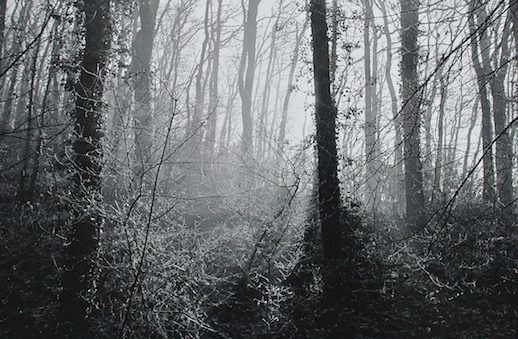Arboreal: A Collection of New Woodland Writing, edited by Adrian Cooper, is our Book of the Month for November.
(Little Toller, hardback, 326 pages. Out now)
Review by Emma Warren
Some things are easier to see when you look away. The most interesting pieces in this prodigious collection, then, take a sideways perspective on trees, woods and forests.
Faber poet Zaffar Kunial conjures up his childhood self, sitting inside a laburnum tree at the end of his Birmingham back garden. The tree is both teacher and timepiece: his dad will come home from a summer in Kashmir when all the leaves have fallen from his tree, although he quickly learns that shaking them off won’t bring him back any quicker.
There are views from bogs, chimeric virgin forests, trains (my new favourite phase is “railway carriage cinema” courtesy of gardener-writer Paul Evans) and from mining villages. The woods that have been nurtured on former pit lands, says writer Sue Clifford, “offer tribute to those who hacked at 300 million year old forests underground and who, convalescing from the working day on returning to the light, knew more about the woods of the Anthropocene than most of us.”
Poet Jen Hadfield’s contribution hums with a neat thought. What if we love trees just because they’re big? Her essay is located on rocky Shetland, where menhirs are ‘deeply rooted’, where outsize stones have thick veins of quartz like coconut meat and where she rubs her cheek against a raised spine of schist ‘like a tiger on a branch’. Maybe, you think as she recasts arborophilia as a deep human need for scale, all we need is to be small sometimes.
The essays, short stories and poems were put together in memory of historical ecologist Oliver Rackham and aim to raise money for charity Common Ground. This might be a collection in memoriam but some of the stories look ahead, most successfully in the hands of forest scientist Gabriel Hemery, as he looks past the current landscape and imagines the transcript of a 2050 interview with his 82-year-old self. Dartmoor is fully wooded all the way to Plymouth and – mentioned casually – there’s food rationing.
Forestry Commission Pine plantations form one of the rage seams in the book, alongside a communal disdain for people who want to clear away deadwood. The ex-Director General of the National Trust does a great job of explaining why they exist: tax breaks were offered on conifer planting – no matter how inappropriate – both on sowing and at harvest (yes, twice!), until this was removed by Nigella Lawson’s then-Chancellor dad in 1988.
Enclosure comes up repeatedly – most notably in author Will Ashon’s enjoyable piece about Epping Forest’s Gypsy Stone. It’s a subject with contemporary resonance, not least because our 21st century commons of state schools and hospitals are being handed over to private companies just like communal forests, parks and heath were gifted by government to the already wealthy between 1604 and 1914.
Any book celebrating trees, though, must really justify the slaughter; otherwise it’s like making a PETA t-shirt out of pelt. At least a handful of writerly saplings could have been uprooted to give the remaining words more light in this sizable hardback: I have a lot of respect for Germaine Greer but her inclusion honestly reads like the result of an afternoon at the Google.
Entries like Tim Dee’s more than make up for the occasional weedy one. His piece about a Cambridge fen is cover for a powerfully decomposed rendering of the woodcock – a ‘snowman bird in night shades’ – in a piece that is drenched in boggy browns and decaying greens. The references take him in and out of the woods: he sees a woodcock over the M42, and eats another in Soho. “Every now and again we catch something that carries more of the mulched life it is made from than the green life is it flying now … the brown woodcock, rotting forever, is a bird flying out of the past.”
Philip ‘Levithian’ Hoare’s equally brilliant contribution rolls out the epic connections sparked by his polymath mind. His New Forest is dappled with apocalyptic sects, tower-building spiritualists, and Victorian attempts to disafforest the area. Other standout moments include poet Richard Skelton’s sculptural ‘Thwaite’, which brings together the linguistic evolution of five trees in a work that is the soft silence in the heartwood of an old tree. It’s beautiful, and contains a pub quiz gem: the etymology of Björk’s name is ‘birch’.
There’s so much in here: photographs of Andy Goldsworthy’s woodland sculptures and David Nash’s postcards that were sent out to 56,000 homes in the wake of 1987’s Great Storm to tell the tidy-upperers that that fallen trees are not dead trees; short stories from Ali Smith and Alan Garner; poetry from Kathleen Jamie and Simon Armitage and a fantastic essay from Irish poet Seán Lysaght.
Oliver Rackham, who departed to the great woods over the hills in 2015, is present throughout. He is, says one contributor, a ‘woodland historian who became part of woodland history’ and he’s evoked constantly, whether it’s in the discussion of ancient woodland (he coined the phrase and, more importantly, the environmental concept) or the boundaries of human rights and responsibilities. Arboreal offers a prismatic view on his influence at a time when woods and forests face rapid climate change.
Richard Mabey’s last word synthesises all of this. He’s observing a geriatric tree that has succumbed to gravity and is ruminating on this snapshot of woodland evolution. “This famous tree has entered the next phase of its existence,” he says. “For a moment, everything is perfectly poised. What should we do?”
*
Arboreal: A Collection of New Woodland Writing is available in the Caught by the River shop, priced £20.
